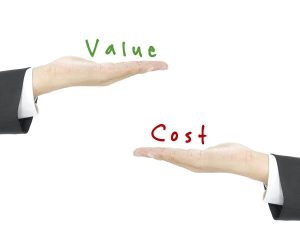 For many small businesses and startups, managing their cash flow is a continual challenge. Questions that come up often are:
For many small businesses and startups, managing their cash flow is a continual challenge. Questions that come up often are:
- How do we manage seasonal peaks and valleys?
- How can we keep our cash working for the business throughout the year?
- What’s the best way to use excess cash to benefit the business?
Good cash flow projections will help any business stay on course towards a brighter future. If you have you ever heard the expression, “Failing to plan is planning fail” then you know how important cash flow projections are to the financial health of your business.
What is a cash flow projection?
A projected cash flow statement lays out a prediction of your company’s available funds over a period of time. It represents cash receipts minus cash payments (income and expenses) over a particular time period (e.g., month, quarter, year). It is a fundamental and vital business tool.
Cash flow projections affect and inform all areas of your business, from human resources to various operational concerns. A good cash flow projection should be realistic and based on your annual operating budget, prevailing market conditions, industry trends, and prior sales cycle data. This will all affect decisions about your inventory (retailers, manufacturers, distributors), staffing levels and payroll, business loans, and your accounts payable process.
If your business is in startup mode, a cash flow statement involves compiling a comprehensive list of budgeted expenses and a conservative estimate of revenues as well as the timing of payments and receipts. Professional and licensing fees, incorporation costs, security deposits and other expenditures associated with starting a business must be included.
Looking at these metrics will help you identify your company’s anticipated cash flow from income and expenses by month (which in turn informs your budgeting process). By updating these cash flow projections on a regular basis, using the actual financial records (receipts, checking account figures, etc.) you will be better prepared to keep that cash flow in the positive column. Managing your cash flow by having smart projections will also affect your company’s credit, as a lender will want to see those projections as part of the business loan process.
How cash flow projections help small – and all – businesses
Decisions that are guided by your company’s cash flow projection may include:
Accounts receivable – You can’t pay your company’s bills if you aren’t being paid by your customers. Cash flow projections will guide decisions about the payment terms to institute from your customers. For instance, does it make good fiscal sense to accept credit cards? What about offering discounts for early payment?
Sales forecasts – How accurate are the sales forecasts and how can we meet them?
Budgets – Budgets are vital road maps to keep companies on track against their actual income and expenses. A cash flow projection by month or by quarter will inform the budgeting process and then help business owners and managers course-correct as needed.
Inventory management – What’s on hand and how do you pay for it? How quickly does your inventory convert to cash? Do your vendors insist on large minimum orders or can you go on a smaller on-demand ordering system?
Business line of credit – You might need a line of credit from your bank to sail through seasonal cash flow crunches; a solid projection will help you get the credit you need to remain viable throughout the year. Another factor here is how debt service impacts your monthly cash flow.
Business loans – If you plan on making capital improvements or will be expanding and need business capital, showing the lender a smart cash projection chart will show you are keeping strong financial records and have long-range plans in place that align with your financials.
Excess cash – If your company is profitable and you find your cash flow is positive, take a look at projections to determine how to use that extra cash. Should you reinvest in the company (and avoid that business loan)? Pay down business debt? Expand into new markets? Award employee bonuses?
In short, projecting your sales and the accompanying cash those sales bring to your company will help you develop smarter budgets and guide more informed business decisions. Cash management will help you prepare for surpluses and deficits.
Getting started on developing your company’s cash flow projection
It all starts with accurate, timely accounting records. Most accounting software will provide cash flow and budget reporting. Or, ask us about our bookkeeping services for small businesses to get your financial records set up properly and maintained regularly.
Want to know more? Download our free Managing Your Small Business’ Cash Flow Guide to find out how to make the most of the money flowing into and out of your business. It’s filled with helpful tips and industry secrets to keep your revenue working as hard as you do.






 It all comes down to passive and non-passive activities related to property.
It all comes down to passive and non-passive activities related to property. Any real property development, redevelopment, construction, reconstruction , acquisition, conversion, rental, operations, management, leasing or brokerage trade or business qualifies as real property trade or business.
Any real property development, redevelopment, construction, reconstruction , acquisition, conversion, rental, operations, management, leasing or brokerage trade or business qualifies as real property trade or business.

 First, consider that your rental property (like many other businesses) may not yield positive cash flow at first. Improvements to the property, tenant issues, and other expenses may end up putting you in the negative column. If you do end up with a rental loss, you are subject to complex IRS rules regarding how much of your rental losses you may deduct from other income you earn during the year.
First, consider that your rental property (like many other businesses) may not yield positive cash flow at first. Improvements to the property, tenant issues, and other expenses may end up putting you in the negative column. If you do end up with a rental loss, you are subject to complex IRS rules regarding how much of your rental losses you may deduct from other income you earn during the year.

 The Internal Revenue Code, the Internal Revenue Service (IRS), and taxpayers have been in conflict over whether expenditures on tangible property are deductible now, or must be capitalized and recovered through depreciation over time. The distinction between deductible repairs and capital improvements has been determined largely through case law and is based upon facts and circumstances.
The Internal Revenue Code, the Internal Revenue Service (IRS), and taxpayers have been in conflict over whether expenditures on tangible property are deductible now, or must be capitalized and recovered through depreciation over time. The distinction between deductible repairs and capital improvements has been determined largely through case law and is based upon facts and circumstances.

